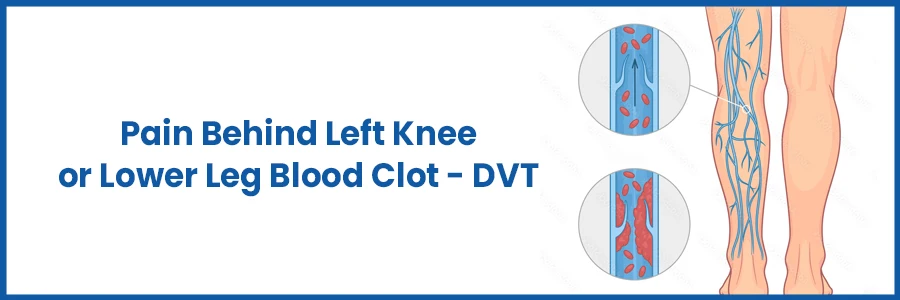
Deep Vein Thrombosis (DVT) is a serious condition characterized by the formation of blood clots in deep veins, typically in the legs. One common symptom of DVT is pain behind the left knee or in the lower leg.
What is DVT?
Deep Vein Thrombosis occurs when a blood clot forms in one or more of the deep veins in the body, usually in the legs. These clots can partially or completely block blood flow, leading to various complications.
Pain Behind Left Knee Blood Clot
Pain in the decreased back of the left knee may additionally moreover have several motives, beginning from muscle strains to vascular issues. One of the massive issues related to this ache is the possibility of a blood clot, furthermore called deep vein thrombosis (DVT). DVT will upward thrust up at the same time as a blood clot administrative center artwork in a deep vein, frequently inside the legs. This clot has the functionality to break unfastened, go through the bloodstream, and become lodged within the lungs, posing excessive fitness risks.
Secure your health with a second opinion. Make informed decisions and book your appointment today!
Get A Second OpinionCauses of DVT:
- Prolonged immobility, such as during long flights or bed rest.
- Injury to a vein, often due to surgery or trauma.
- Certain medical conditions or treatments that affect blood clotting.
- Family history of blood clots.
- Pregnancy or recent childbirth.
- Smoking and obesity are also risk factors.
Symptoms of DVT:
- Pain or tenderness, often felt as a dull ache, behind the left knee or in the lower leg.
- Swelling, warmth, or redness in the affected area.
- Skin discoloration.
- Visible veins.
- Some people may not experience any symptoms, making DVT a silent threat.
Risk Factors of DVT:
Certain factors increase the risk of developing DVT, including:
- Age over 60
- Obesity
- Smoking
- History of DVT or pulmonary embolism
- Use of hormone replacement therapy or oral contraceptives
- Pregnancy or recent childbirth
- Cancer treatment
Diagnosis and Treatment Options:
If you suspect you have DVT, it's crucial to seek medical attention promptly. A healthcare provider may perform a physical examination, ultrasound, or other imaging tests to diagnose DVT accurately.
- Treatment for DVT aims to prevent the clot from growing larger, reduce the risk of complications like pulmonary embolism, and prevent the formation of new clots. Common treatment options include:
- Anticoagulant medications (blood thinners).
- Thrombolytic therapy (clot-dissolving medications).
- Compression stockings.
- In some cases, surgery may be necessary to remove the clot.
Prevention:
- Stay active and avoid prolonged periods of immobility, especially during long trips.
- Maintain a healthy weight and avoid smoking.
- If you have risk factors for DVT, talk to your doctor about preventive measures.
- If you're undergoing surgery or have other medical conditions, your healthcare provider may prescribe blood thinners to reduce the risk of blood clots.
Conclusion:
Pain behind the left knee or in the lower leg can be a warning sign of Deep Vein Thrombosis, a potentially life-threatening condition. Understanding the causes, symptoms, and treatment options for DVT is crucial for early detection and prevention of complications. If you experience persistent pain or swelling in your legs, seek medical attention promptly to rule out DVT and receive appropriate treatment.
Ready to take control of your health journey? Book your appointment now and start your path towards wellness today!
Book an AppointmentFrequently Asked Questions
Yes, it could be a symptom of Deep Vein Thrombosis (DVT), a serious condition requiring medical attention.
Common symptoms include pain, swelling, warmth, and redness in the affected leg. Seek medical advice if you experience these symptoms.
Diagnosis typically involves ultrasound imaging to detect blood clots in the veins. Prompt diagnosis is crucial for effective treatment.
Risk factors include prolonged immobility, surgery, certain medications, genetic predisposition, and underlying health conditions like obesity and cancer.
Preventive measures include regular movement, staying hydrated, avoiding prolonged sitting or standing, wearing compression stockings, and following your healthcare provider's recommendations. Removing waste matter from the body is crucial for maintaining overall health and reducing the risk of DVT.